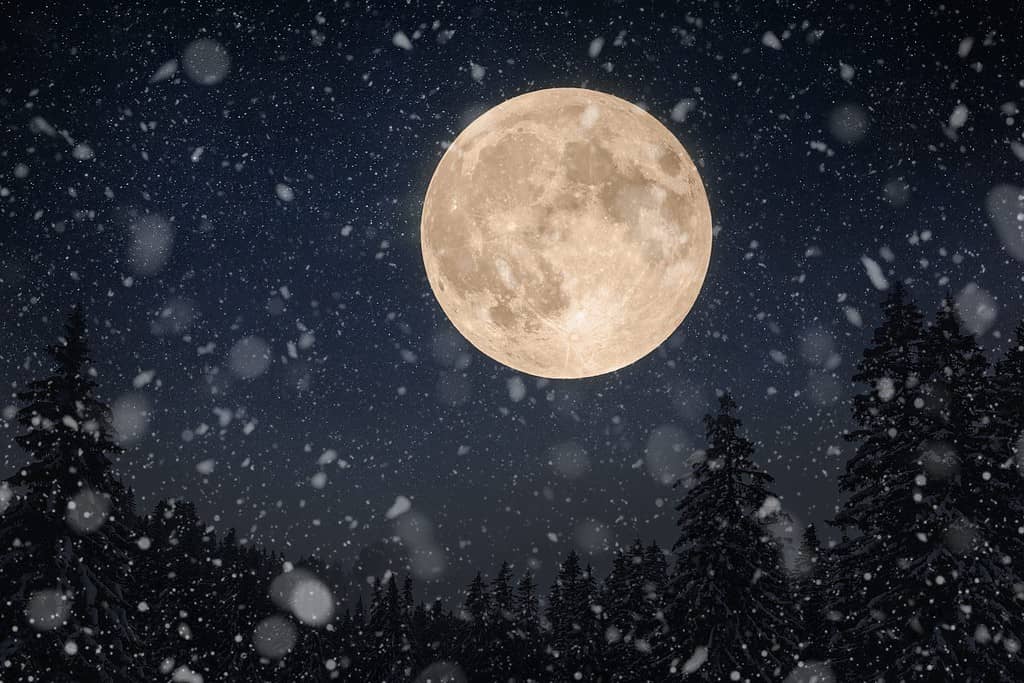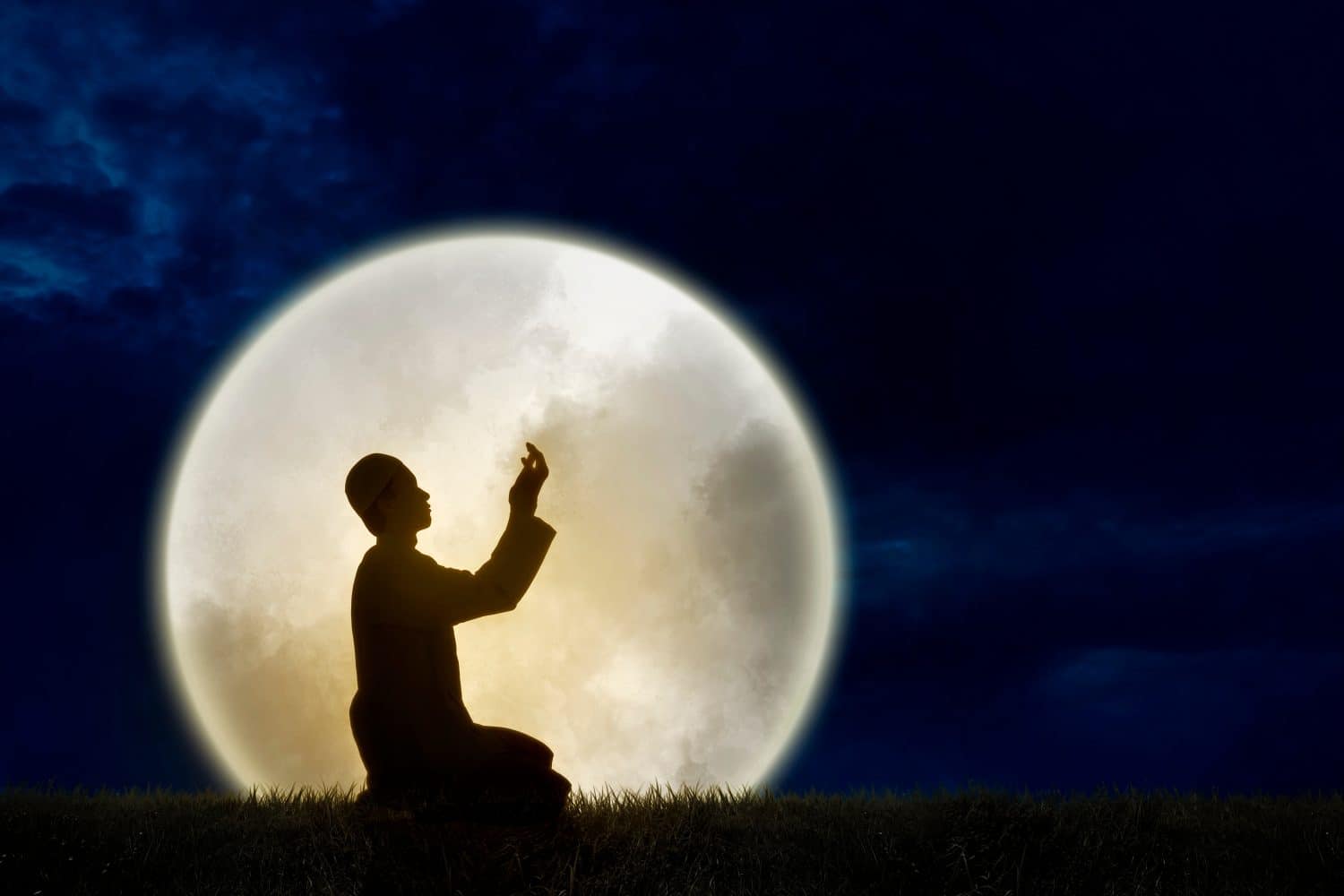February is a time for Valentine’s Day, snow, and, of course, February’s Snow Moon. Whether you are a big fan of all that is lunar or thoroughly enjoy cultural ideas on what this full moon means, this article is for you. We will look at how our ancestors felt about February’s full moon and all the myths and legends surrounding it. Get your binoculars and telescopes ready for this nighttime event. Let’s discover the origin and meaning of February’s full moon, the Snow Moon, happening on Saturday, February 24, 2024, at 7:30 am EST.
Origin of the Snow Moon

Like the wintertime, the Snow Moon always appears colder than the full moon during the warmer months.
©YouraPechkin/Shutterstock.com
There isn’t one answer as to why the Snow Moon was given the name. It is likely because, in the Northern Hemisphere, February is a very snowy month. It wasn’t always known by the title “Snow Moon” by everyone. Native Americans have their own names for the winter full moon. The Cherokee referred to it as the “Hungry Moon” and the “Bony Moon” due to the hardship of hunting throughout the frigid month.
It has been long thought that Native Americans named each month’s full moon since there was no other way to tell when months had passed. This likely isn’t true; the Native Americans knew far more about everything than anyone gave them credit for, including time. January’s full moon, the “Wolf Moon,” may have been because a tribe heard many wolves howling during one.
Tribes in the northwest referred to the moon as the “Storm Moon” due to the tendency for most to produce heavy snow storms in the region. Other tribes have referred to it as the “Bear Moon” because the full moon falls at a time when bear cubs are born. Celtic and Old English texts refer to it as the “Storm Moon” and the “Ice Moon.”
Every 19 years, February does not have a full moon; instead, it has what is called the “Black Moon.” Due to time zone differences, not all parts of the world will experience a missing moon event.
Lunar Traditions and Beliefs

©Alones/Shutterstock.com
Across the globe, different cultures and groups believe the Snow Moon holds differing symbolism. Those who closely follow astronomy believe the Snow Moon symbolizes this year’s arrival of the Snow Moon in Leo. Leo is a sign known for its fiery energy, creative expression, and big heart. Many will feel excited to embark on an adventure or to express themselves loudly through music, writing, or art. Others may feel as if their reserve is running out. Now is a time of waiting and cleaning out the old “pantry” to prepare for what is coming.
This goes hand in hand with the Native Americans’ belief that the Snow Moon is a famished and skinny time before restocking. This is a time to embrace the cold, quiet nature of winter and know that soon, the days will grow longer, and life will once again become busy filling the reserves once depleted. Mentally, that means enjoying this moment of peace and stillness of life as we prepare for the next chapter. Check your horoscope for February 5, 2024, for more details.
Celebration and Rituals

©Creativa Images/Shutterstock.com
During the Snow Moon, Pagans celebrate Imbolc on February 1. The Imbolc is the halfway point between the Winter Solstice and Spring Equinox. It is a time of clarity and renewal. Consider burning some candles and bathing to rid yourself of the old. This helps make way for the new chapter of the year and your life. The color of the candles is up to you and what you are trying to manifest. Add a bit of lavender to the bath for an additional calming agent.
If you choose to smudge your home, do so with sage or palo santo. Make sure to spend time in every room, covering all spaces in each. Before you begin, open a window in each room so that any bad energy escapes. You can also smudge your crystals to rid them of any leftover toxic energy and welcome in the new chapter. Consider what you want to focus on for the next segment of the year and collect your appropriate crystals. This can be completed before taking your cleansing bath.
Worldwide Rituals and Ceremonies
Native Americans used certain ceremonies to ward off evil spirits. Some tribes believe that the Snow Moon is especially riddled with lost spirits since many animals and humans die during the winter months. It was important that the dead be acknowledged, or they would continue to reappear to the living. Because of this, they used dancing and ceremonies to chase the spirits back to where they belonged to make way for spring since the Snow Moon is the last full winter moon.
In Europe, the Snow Moon symbolizes the beginning of the planting season. Ancient Persians lit fires to symbolize the rebirth of the land after the harsh winter months were drawing to a close. The Celts practiced cleansing rituals since they believed the veil between the living and the dead was weakest during the Snow Moon. Ancient Romans used this time for ceremonies to the goddess Februa, who stands for purification and death.
The photo featured at the top of this post is © Rastan/iStock via Getty Images
Thank you for reading! Have some feedback for us? Contact the AZ Animals editorial team.







